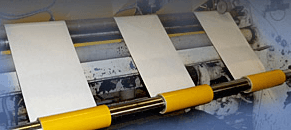The Slitting and Rewinding Machine: What You Need to Know

What is a slitting machine?
As you familiarize yourself with the slitting and rewinding machine, become familiar with one word in particular: converting. In regards to this process, converting means slitting. Typically, we use converting equipment like foils, paper, and film. These materials often come in roll form. When we apply the slitter machine, we’re able to cut them into narrow rolls. The narrower the roll, the easier it is to handle.
To make it simple, think of a slitting machine as its three main components. These include the unwind, the slitter, and the rewind. The slitter itself has an unwind. Usually, you’ll feed a large roll of material through the slitter’s unwind. This in itself is actually what causes the material to unwind in the first place. Subsequently, the machine slits the material into varying widths. It’s then rewound into different cores.
Think of it this way: when you feed material into slitters and rewinders, it enters in one form. The machine ensures that you receive it back in a simplified, more workable form. One of the benefits of utilizing this process is that these simplified materials may work better for different purposes.
Who runs the slitting and rewinding machine?
Needless to say, a slitting machine requires direction. That direction comes from a slitting equipment operator. The operator is not only responsible for operating the machine, but setting it up and managing it in general. Additionally, we rely on the operator to check pre-determined tolerances. When the machine offers a final product, it’s up to the operator to inspect that product for any major flaws.
With that in mind, you’re putting a lot of trust into a slitting machine operator. This means you need to be sure about who you’re working with—or for that matter, outsource to a slitting factory. Companies like Conversion Technologies International offer processing services, which means you won’t have to hire or train a permanent employee. That saves you a lot of time, money, and stress.
What is a rewinding machine?
We use a rewinding machine for a specific purpose–sometimes in conjunction with a slitting machine. The materials we’ve discussed often come in a roll form. Feeding that material through a rewinding machine, we’re able to work it into a smaller roll, or perhaps a roll in a somewhat different shape. Think of it this way: a rewinding machine also functions as a “reworking” machine.
Usually, what makes up this type of machine includes a series of different drums and rollers. These components take in the material, while a drive systems rotates them throughout the process. When a rewinding machine features slitting components or cutting systems, you have a slitting and rewinding machine.
As we mentioned earlier, the operator executes crucial functions with regards to these machines. Not only do they feed the material into the machine–they also set the winding parameters. These parameters determine the ultimate results of the machine’s work. They include the width of the material, the size of finished roll, and the width of the final material. When the machine winds the material onto the component we call the “spindle” or “core”, the rollers and drums control the tension.
Remember: you’ll find multiple different types of rewinding machines. Among them are center winders, coreless winders, and surface winders. It’s important that you understand the type of project you’re considering ahead of time, as well as what you need from your final product. This will ensure that you find the right machine immediately.
How many types of slitting methods are there?
Here’s the good thing about the slitting process: no matter what you need executed, you’ll likely find a process that matches your requirements. The main processes include:
Razor Slitting
With this process, we mount a razor blade onto a slitting machine, slicing the materials into targeted widths as they pass through. The conversion method can work quickly, by using razors placed on the bottom, or slowly, by using blades placed on the top. Usually, we use razor slitting when shearing thin layers, like films.
Score or Crush Slitting
Usually, we use this process when we need layers of varying levels of rigidity and thickness. Here, we move the substrate between a solid rotating anvil and circular rotating knife or series of knives. This is actually the most common method of the three options. While it doesn’t suit every project, it does work for many.
Shear Slitting
The third method utilizes a two-part knife. We refer to the ends of this knife as the “male” end and the “female” end. The substrate passes through the two parts–that’s how we cut it. The benefit of this method is that it’s quite fast and converts different types of thin materials quite efficiently.
When working with a slitting and rewinding machine, you’ll want as much flexibility as possible. The better the machine you select fits your project, the easier it will be for you to make the project work to your roll processing specifications. The question is, where do you start? You may want to begin with a third-party slitting and rewinding manufacturer.
A third-party manufacturer handles projects beyond slitting and rewinding—you can also outsource for processes like die cutting. No need to buy a die cutting machine when you outsource to a responsible manufacturer!
Want to learn more? No problem. Contact CTI here or call us at 419-924-5566. We’re ready to help.
- << < Previous Post
- 1
- 2
- ...
- 14
- ...
- 250
- 251 Next Post > >>

